STUDENTS PROJECTS
PROJECTS 2011
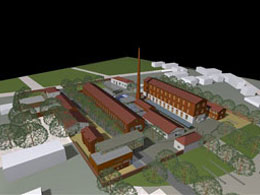
14 June, 2011
Restoration and reuse of the Tzivre silk mill in Soufli
The subject matter of our diploma project has been the study for the restoration and reuse of the Tzivre silk-mill in Soufli.
Students: Giannakoudi Ioanna , Bouchouna Morfo
Supervisor: M. Nomikos
ARISTOTLE UNIVERSITY OF THESSALONIKI - School of Architecture
Date : 23/02/2011
The subject matter of our diploma project has been the study for the restoration and reuse of the Tzivre silk-mill in Soufli, which is the oldest and most important industrial complex of Soufli. It also constitutes the unique saved structure of industrial architectural complex of silk-mills in the region of Eastern Macedonia and Thrace and is one of the most representative and expanded industrial complexes of the beginnings of the 20th century in the wider Balkan area. It was built in 1909 and it functioned successfully up to 1958.
The factory symbolizes the industrial acne of the city in the beginning of the 20th century, as well as the particular culture of silk, and even today, abandoned and devastated, it continues characterizing the city. Located in the entrance of the town, the complex with the very tall chimney constitutes a reception gate in a place of historical memory, which carries the indelible seal of silk.
Analysis
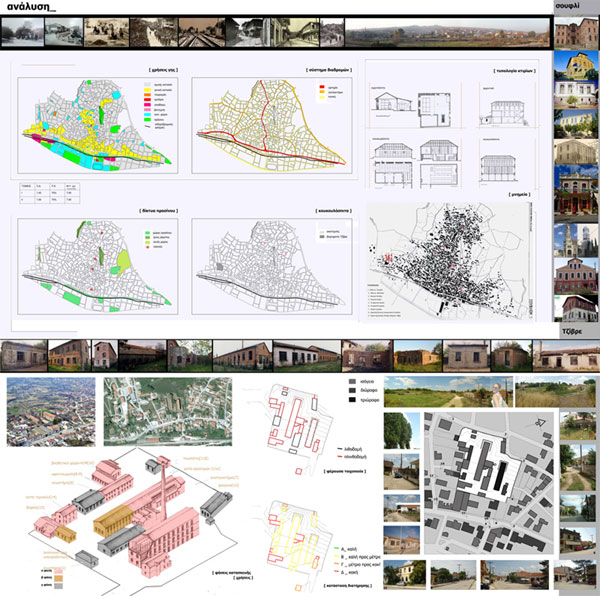
The complex is located in a 10.500sqm plot and consists of 14 buildings, from which the most important are: the three-level tumble dryer of cocoons "xirantirio" - 469sqm total area and 5900cu m volume- covered with wooden beds for the silk warms called "krebatines" in all its height and total surface 2915sqm, the ovens where "apopnixi" of the cocoons took place, the "anapinistirio" -500sqm, 3000cu m- with 94 basins, the "yfantoyrgeio - klostirio" - silk-mill with 24 textile webs and of course the 35 meters height bricklayer chimney.
The holder structure mostly consists of bricks, cement and is founded in perimetric stonemasonry. For bridging the openings, arched brick transoms or cement lintels are used. The roofs have wooden skeleton and wherever the use of wooden elements was deterred by the conditions in the building, metal tractors were used.
Nowadays, the entire complex is characterized as historical preservable monument and work of art.
Almost all the buildings shells remain in satisfactory condition (except for certain ones that are found in wrecks), with important however deteriorations. There are old installations of exceptional interest rescued in some buildings, because of both the age and their rarity, as the "krebatines"- the old "beds" for the silk warms- in the 3-storey building "xirantirio" and the machines for "anapinisi".
Proposal
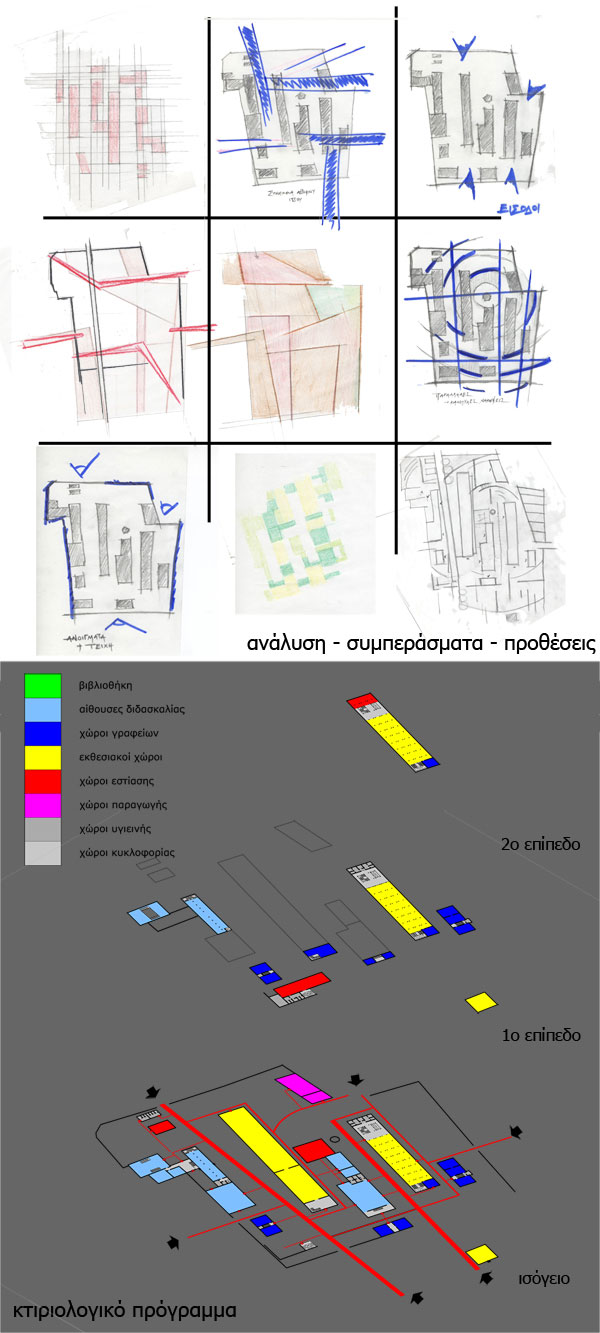
Our objective was the correspondence of the new uses with the complex's importance so as to constitute a multifonctional centre (education, study, production and sale of silk buckrams), a space capable to contribute multiply in the city's upgrade.
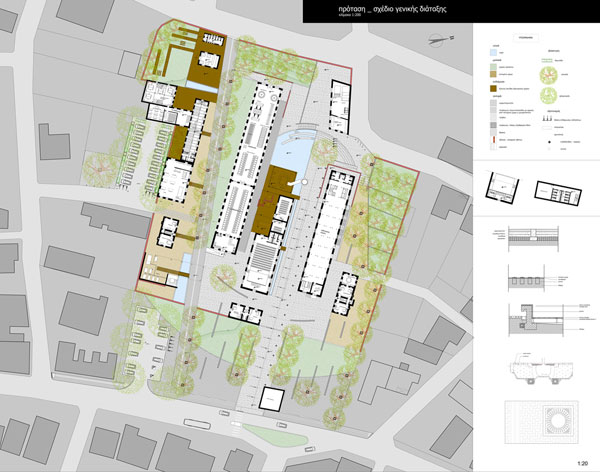
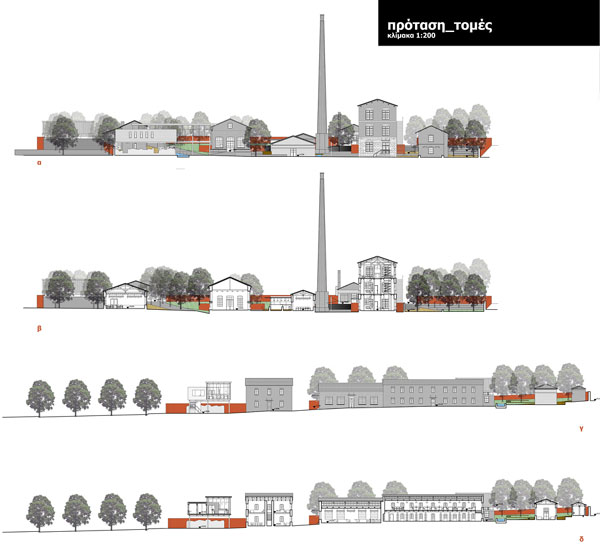
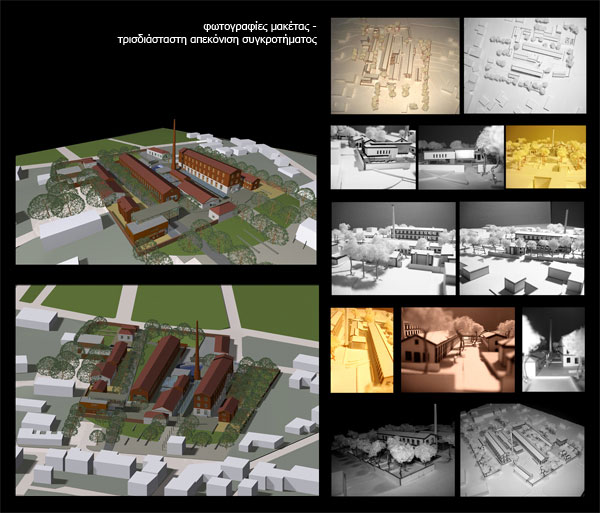
The new uses and activities should also be relevant to the cultural heritage of Soufli and mainly the tripartite silk - flavours - traditional architecture. In supralocal level the complex will function as a pole of attraction for international meetings and visits concerning the silk industry and the industrial heritage in general, while in local level we wish it will create the base for social, economical and cultural growth of the town.
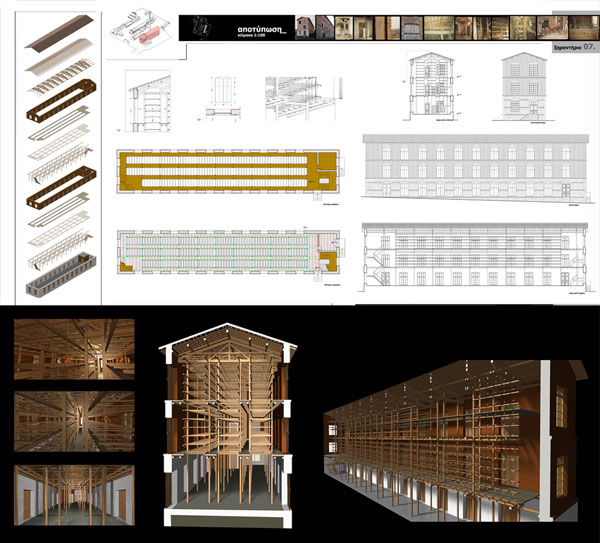
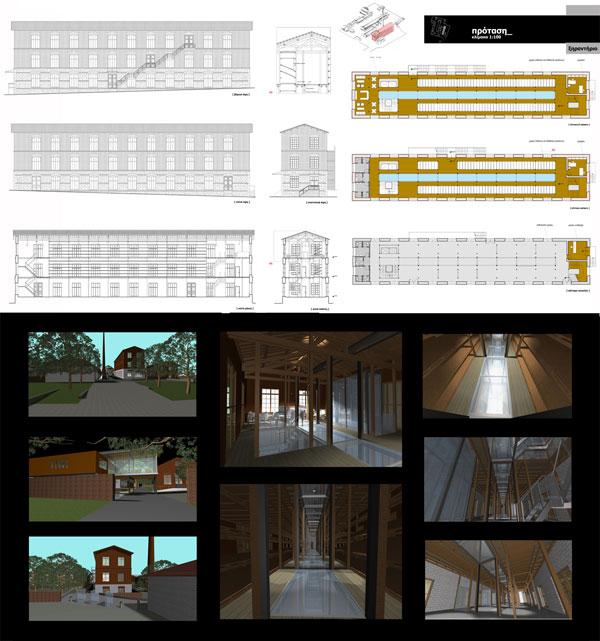
Our proposal highlights the firm volumes and the monumental presence of the 14 buildings and suggests new uses, which are compatible with the physiognomy and the former operation of the factory. Initially we favor the maintainance of all existing installations, the arrangement of an auditorium in the building- storage of cocoons, exhibition spaces and a local products market in the old "xirantirio", a museum of the old production process and new production spaces in "anapinistirio" and finally education facilities in the old "yfantoyrgeia". The building itself and the remaining machinery will work a as an exhibit.
Also, based on the study we considered advisable to make the following additions:
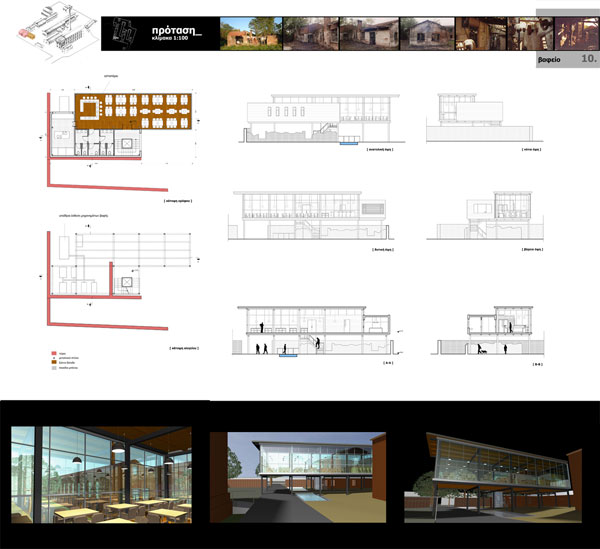
A glass volume, that will function as a restaurant - 84 peolple capacity, with corresponding auxiliary spaces (WC, cooker, deposit). The restaurant is found in a level higher than that of the ground, supported in metal columns, while in the ground level the old equipment of dyeworks is exhibited in glass showcases.
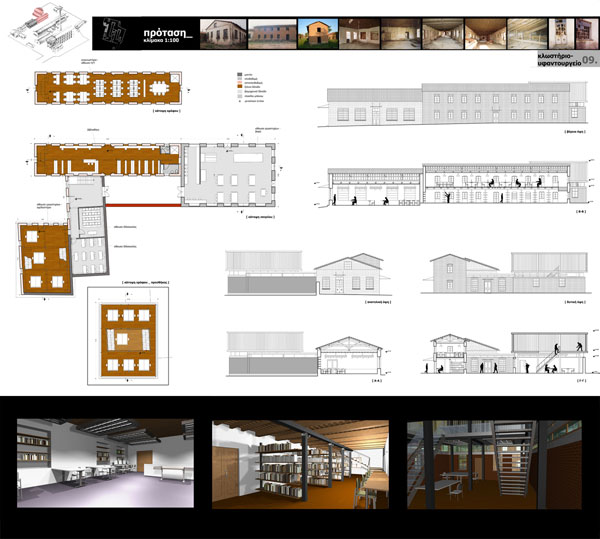
A two-storied building (concrete additions on the ground level, metal structure with glass and wooden blinds in the floor), which will accommodate classrooms and laboratories.
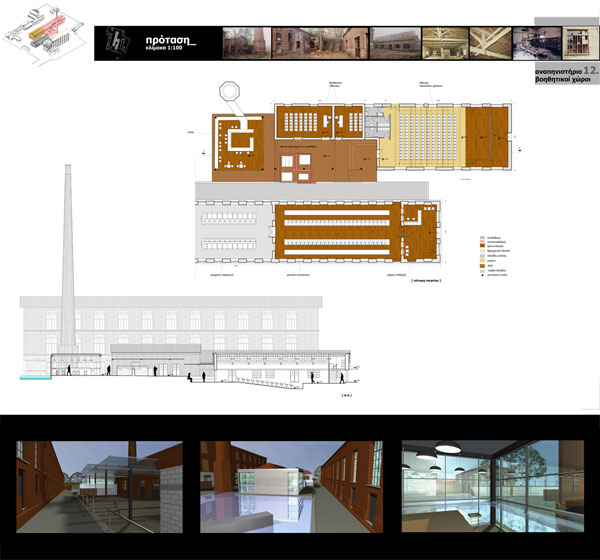
Finally, a glass cube with metal skeleton, which will serve as a small bar and will be the foyer of the adjacent auditorium.
The goal of the landscape design was to contribute to the connection among the buildings and its surroundings and also to attract visitors to the complex.
In general, contemporary elements emerge from the old ones and are completely differentiated as far as materials are concerned. Metal and glass are used for the additions, water for the reflection of volumes and the resurgence of its importance in the operation of the old silk-mill, shelters, lightings and plantings (mulberries) that determine the routes. And then the space remains vacant to be occupied by memory...
Related articles:
- Industrial Building on the fringes of Attiki Odos ( 15 November, 2009 )
- MEDICAL INSTRUMENTS FACTORY AT RAFINA, ATTICA ( 20 October, 2009 )
- Reutilisation of the building T.A.O.L. in Lefkada ( 23 June, 2010 )
- Routes in the paths of emery ( 01 February, 2011 )
- Urban integration and reuse of the former paper industry of Ladopoulos in Patras ( 20 February, 2011 )
- The old factory of Azel ( 04 April, 2011 )
- Project Suggestion for Reusing KOMDE’s industrial complex in Trikala ( 16 August, 2011 )
- Mining Museum in Serifos ( 15 February, 2012 )
- Multi-space of Meditteranean Diet in metropolitan park in Goudi ( 05 March, 2012 )
- Subverting the non use ( 26 March, 2012 )
- Cultural Park in inactive lignite mines of Ptolemaida ( 27 September, 2012 )
- Winery in Nemea ( 01 May, 2012 )
- Industrial landscape in Aliveri ( 16 August, 2013 )
- Memory nd urban sityscape ( 24 May, 2013 )
- Decontamination and Production Mechanism ( 05 February, 2014 )
- Reformation and rehabilitation of an inactive quarry, with spatial location of uses for Tourism, Recreation and Environmental Education ( 10 February, 2014 )
- Redesigning the silo at the historic Allatini Mills ( 09 May, 2014 )
- Restructuring the Industrial Landscape ( 19 July, 2014 )
- inte[R]outes ( 11 December, 2014 )
- Lato and Kekrops Quarries: a walk in the residual landscape ( 28 January, 2015 )
- Print your utopia ( 07 February, 2015 )
- ADAPTIVE REUSE OF A FORMER PAPER FACTORY IN AIGIO AND CONVERSION TO REHABILITATION CENTRE FOR DISABLED PEOPLE ( 12 August, 2015 )










